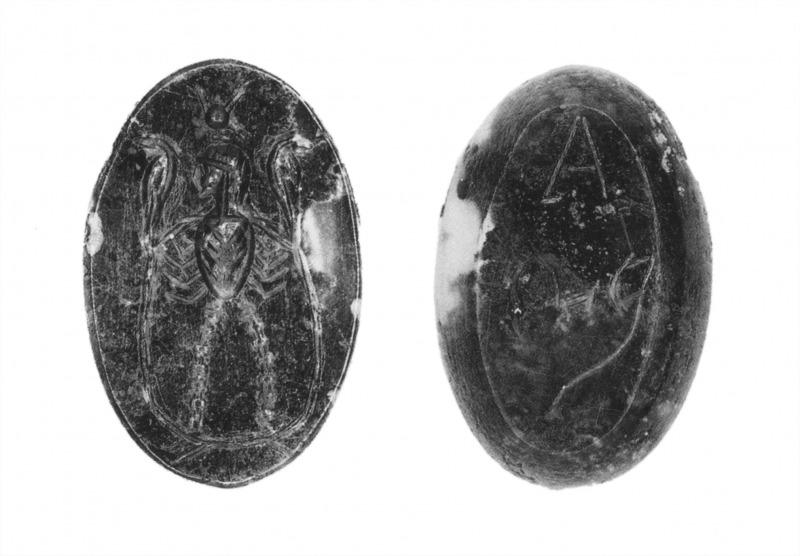Bonner 1951 on CBd-722
C. Bonner, Amulets Chiefly in the British Museum, Hesperia 20, 1951, 301-345, no. 39.
Obv. Figure with human head, apparently female, to l., and body of a scorpion with legs at sides and also a pair of thin insect like legs supporting the body from below. These are made of a succession of short joints like those in a scorpion's tail. The head is apparently covered by a headcloth, unless the engraver wished to indicate long hair falling to the shoulders and covering the ear. Over the head is a disk with two horn like projections. Each hand grasps a cobra; the tails of the snakes meet and cross below. The design is enclosed by a deep groove, not an ouroboros.
Rev. Above, an alpha, below, two uncertain signs. The first resembles an omega, but one of the earlier horseshoe form, not that used on amulets of this period. The second consists of a loop and a wavy tail, and slightly resembles a g of ordinary English handwriting. The inscription is almost certainly later than the work on the obverse and may be modern.
Green jasper shaded with brown. Upright oval, 21 x 15.
Various Egyptian divinities are sometimes represented standing on a double serpent, the two heads of which are grasped by the extended hands of the god or goddess; e. g. Sekhet (Sekhmet), Budge, Gods, I, p. 514; Lanzone, pl. 363, 4. Isis is seated with the infant Horus over a double serpent, Lanzone, pl. 310, 3. Numerous minor deities of the underworld are so shown.
The figure may be a late conception of the scorpion goddess Serqet (Selket), who is shown in Budge, Gods, II, p. 377. SMA, p. 159 ad fin. is to be corrected by the description above. A somewhat similar figure is to be seen on the reverse of the Metternich stele, second row, fourth from left.
Obv. Figure with human head, apparently female, to l., and body of a scorpion with legs at sides and also a pair of thin insect like legs supporting the body from below. These are made of a succession of short joints like those in a scorpion's tail. The head is apparently covered by a headcloth, unless the engraver wished to indicate long hair falling to the shoulders and covering the ear. Over the head is a disk with two horn like projections. Each hand grasps a cobra; the tails of the snakes meet and cross below. The design is enclosed by a deep groove, not an ouroboros.
Rev. Above, an alpha, below, two uncertain signs. The first resembles an omega, but one of the earlier horseshoe form, not that used on amulets of this period. The second consists of a loop and a wavy tail, and slightly resembles a g of ordinary English handwriting. The inscription is almost certainly later than the work on the obverse and may be modern.
Green jasper shaded with brown. Upright oval, 21 x 15.
Various Egyptian divinities are sometimes represented standing on a double serpent, the two heads of which are grasped by the extended hands of the god or goddess; e. g. Sekhet (Sekhmet), Budge, Gods, I, p. 514; Lanzone, pl. 363, 4. Isis is seated with the infant Horus over a double serpent, Lanzone, pl. 310, 3. Numerous minor deities of the underworld are so shown.
The figure may be a late conception of the scorpion goddess Serqet (Selket), who is shown in Budge, Gods, II, p. 377. SMA, p. 159 ad fin. is to be corrected by the description above. A somewhat similar figure is to be seen on the reverse of the Metternich stele, second row, fourth from left.
Last modified: 2016-05-24 20:23:18
Link: cbd.mfab.hu/pandecta/907
